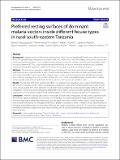Preferred resting surfaces of dominant malaria vectors inside different house types in rural south-eastern Tanzania

View/
Date
2020-01-15Author
Msugupakulya, Betwel J.
Kaindoa, Emmanuel W.
Ngowo, Halfan
Kihonda, Japhet M.
Kahamba, Najat F.
Msaky, Dickson S.
Matoke-Muhia, Damaris
Tungu, Patrick K.
Okumu, Fredros O.
Metadata
Show full item recordAbstract
Background: Malaria control in Africa relies extensively on indoor residual spraying (IRS) and insecticide-treated nets
(ITNs). IRS typically targets mosquitoes resting on walls, and in few cases, roofs and ceilings, using contact insecticides.
Unfortunately, little attention is paid to where malaria vectors actually rest indoors, and how such knowledge could
be used to improve IRS. This study investigated preferred resting surfaces of two major malaria vectors, Anopheles
funestus and Anopheles arabiensis, inside four common house types in rural south-eastern Tanzania.
Methods: The assessment was done inside 80 houses including: 20 with thatched roofs and mud walls, 20 with
thatched roofs and un-plastered brick walls, 20 with metal roofs and un-plastered brick walls, and 20 with metal
roofs and plastered brick walls, across four villages. In each house, resting mosquitoes were sampled in mornings
(6 a.m.–8 a.m.), evenings (6 p.m.–8 p.m.) and at night (11 p.m.–12.00 a.m.) using Prokopack aspirators from multiple
surfaces (walls, undersides of roofs, foors, furniture, utensils, clothing, curtains and bed nets).
Results: Overall, only 26% of An. funestus and 18% of An. arabiensis were found on walls. In grass-thatched houses,
33–55% of An. funestus and 43–50% of An. arabiensis rested under roofs, while in metal-roofed houses, only 16–20%
of An. funestus and 8–30% of An. arabiensis rested under roofs. Considering all data together, approximately 40% of
mosquitoes rested on surfaces not typically targeted by IRS, i.e. foors, furniture, utensils, clothing and bed nets. These
proportions were particularly high in metal-roofed houses (47–53% of An. funestus; 60–66% of An. arabiensis).
Conclusion: While IRS typically uses contact insecticides to target adult mosquitoes on walls, and occasionally roofs
and ceilings, signifcant proportions of vectors rest on surfaces not usually sprayed. This gap exceeds one-third of
malaria mosquitoes in grass-thatched houses, and can reach two-thirds in metal-roofed houses. Where feld opera‑
tions exclude roofs during IRS, the gaps can be much greater. In conclusion, there is need for locally-obtained data on
mosquito resting behaviours and how these infuence the overall impact and costs of IRS. This study also emphasizes
the need for alternative approaches, e.g. house screening, which broadly tackle mosquitoes beyond areas reachable
by IRS and ITNs.
